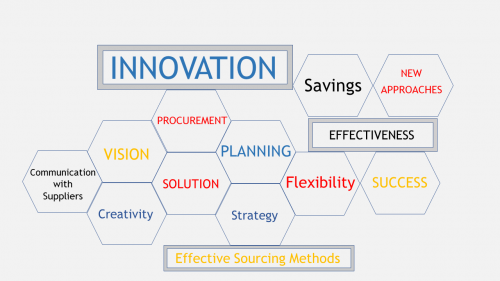Public procurement professionals often need to ask themselves, “Should we innovate, or can we use our traditional sourcing methods more effectively?” Many state central procurement offices have answered “Both!” to this question with much success.
Innovation continues to be a buzzword. We often hear calls for government innovation and rethinking public procurement, especially due to budget constraints or to keep up with the fast pace of innovation in technology.
Innovation can mean implementing new or better solutions. These could include changes as simple as a facelift to a traditional procurement method, adopting a new approach such as modular procurement, simplified multi-step bidding, communications with the supplier community prior to issuing a procurement opportunity or allowing the state to test new technologies before procuring them. Sometimes, the most innovative ideas come from procurement professionals in the trenches who work closely with stakeholders and can offer helpful feedback.
Earlier this year, I had the privilege of hosting a webinar highlighting innovative and effective ways of procuring goods and services in state government.
The NASPO webinar discussion focused on supplier forums, reverse auctions, and Public-Private-Partnerships (P3s). The Chief Procurement officer, Jenny Doherty (Pennsylvania), offered insight on how to conduct effective reverse auctions and supplier forums, which have been successful in her state. Supplier forums are unique in-person Requests for Information where state buyers get input from potential suppliers prior to issuing a solicitation. Jenny emphasized the importance of having informal communications with suppliers before an upcoming opportunity in an open and equitable manner to gather feedback on solutions available on the market, best contracting mechanisms, pricing, and best practices.
reverse auctions and supplier forums, which have been successful in her state. Supplier forums are unique in-person Requests for Information where state buyers get input from potential suppliers prior to issuing a solicitation. Jenny emphasized the importance of having informal communications with suppliers before an upcoming opportunity in an open and equitable manner to gather feedback on solutions available on the market, best contracting mechanisms, pricing, and best practices.
P3s are another effective contracting tool available to public purchasers, typically used for construction and infrastructure projects. They allow states and local governments to receive private investment to finance public projects. Todd Allen, Contracting Officer for the District of Columbia’s Government Operations Division, which includes the Office of Public-Private Partnerships, shared his P3 tips with the webinar audience. Todd spoke about the steps that the District took to implement their new P3 Act, the Advisory Services RFP, and current District P3 projects. The District developed a process to evaluate both solicited and unsolicited P3s that may be received from private entities. Also, a robust pool of financial and legal advisors was secured through Indefinite Delivery, Indefinite Quantity (IDIQ) contracts to provide services in support of the District’s P3 program.
Of course, these are just a few examples. State procurement innovation can help improve and optimize the procurement process to achieve cost savings and operational efficiencies in state government. Taking a critical look at the various steps of your procurement process and commonly-used sourcing tools can help you identify opportunities for improvement early in the process. Improvements include:
- Providing a forum to get input in a fair and equitable manner from all potential suppliers prior to issuing a solicitation
- Adding more clarity to the procurement process and utilizing the RFP flexibility so it doesn’t restrict innovative solutions
- Eliminating overly-prescriptive specifications and restrictive bidding instructions
- Updating procurement laws and standard terms and conditions to keep up with the rapid technology advancements and allow for more flexibility when procuring technology solutions.
For more information about ValuePoint Cooperative Contracts, visit https://www.naspovaluepoint.org/

